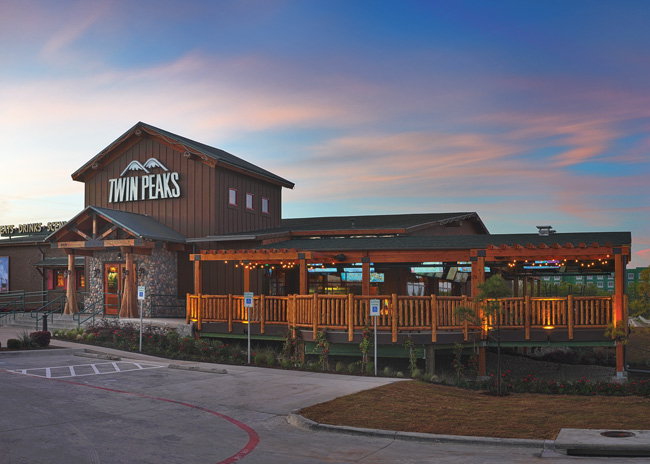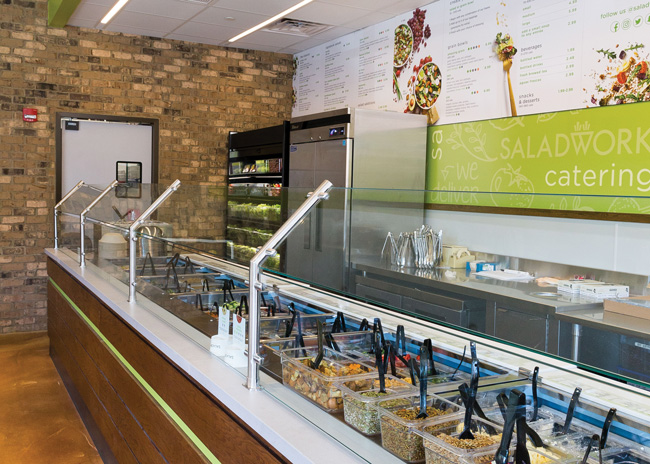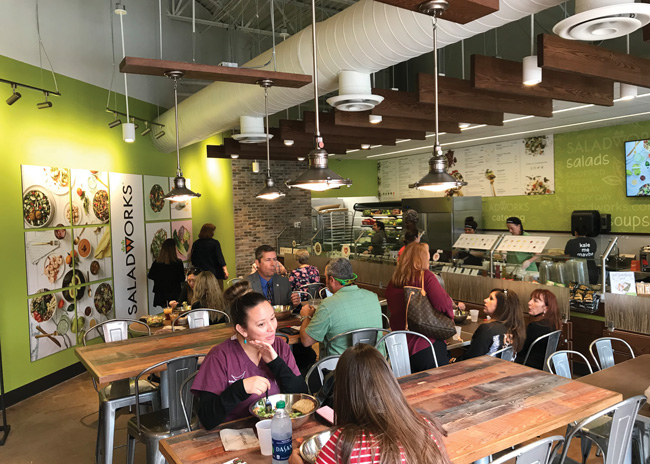The pace of change in today’s restaurant industry is faster than ever before. Not only are consumer tastes in food and design changing, but so are their habits, from who they eat with to what they want out of a restaurant experience and to whether they leave the house at all.
To satisfy these desires, restaurant concepts must be willing to change their design, perhaps often and perhaps radically.
While it would be easier to just toss out some new finishes that look nice, developing a new prototype that will take a brand to the next level requires research, planning and study, along with a healthy dose of introspection and willingness to change.
Assembling a Prototype Team
One of the first steps in developing a new prototype is assembling the right design team. If a chain plans on hiring an outside design firm, there are a few qualities they should look for when evaluating candidates.
One is experience with designing for chains. As many operators and designers interviewed for this article pointed out, designing a beautiful restaurant is one skill set. Designing a beautiful restaurant that is affordable, efficient and easy to replicate that also offers a good return on investment is another.
In the case of fast-casual Saladworks, skill set was a key factor in the company’s choice of Odom Architects out of Mobile, Ala. “What we were trying to do was come up with an initial prototype but also figure out how to roll that prototype out to my existing store base and two stores going forward when no two locations are the same. Odom had really strong experience working with franchises, and we thought that would be the best way to help our franchisees,” says Jena Henderson, vice president of growth for Saladworks.
Twin Peaks, a sports-focused casual-dining chain, is constantly reworking its prototype to drive incremental sales. The chain shrunk its typical store size by roughly 1,300 square feet in recent years, largely by reworking its kitchen and making more efficient use of its space, according to Twin Peaks Senior Director of Development Paul Stevens. They’ve also introduced enclosable patios and used design to highlight a new bourbon program.
As the chain introduces these changes, they’ve employed two different architects, one for ground-up builds and one for moves into existing structures that were previously occupied by another restaurant operation. The architectural skill sets of these two tasks are different enough that there’s real value in hiring firms with expertise in each field, says Stevens.
Whether or not an outside firm is brought in to handle the interior design, chains must also get the right internal team on board. As a rule of thumb, smaller is better. Not only do larger groups take longer to make decisions, but they’re also simply harder to get in the room all at once.
“A lot of the corporate structures are running a little lean, and a lot of the folks we are dealing with are multitasking within the organization. It’s difficult to get all the stars to align so they can all be at the same meeting on the same day. That’s one of the things that causes delays in the project, or at least decision making,” says Thomas Henken, vice president and director of design with api(+), a design, architecture and branding firm out of Tampa, Fla.
Operators shouldn’t go too small, though. It’s important that key players have a seat at the table when developing a new design. This includes marketing and branding, construction, franchise sales/development, kitchen operations and more. Each has a stake and something to contribute to the conversation.
Some operators contend that everyone should be involved throughout the entire design process. According to Cinnabon President Kristen Hartman, who has overseen redesign projects at that chain and several other concepts also owned by FOCUS Brands, this level of involvement improves buy-in.
If, for example, a design choice isn’t ideal for marketing but is essential for the kitchen, understanding the root of that choice will make it easier for the marketing team to accept the decision.
With such a diverse cast of stakeholders, though, making sure everyone understands the design process and its phases is essential, Hartman adds. “In the early stages, we wanted to be aspirational,” she says. “This can be really challenging for some of the people who are involved in the hardcore tactical side of store design. They immediately look at things and think, ‘Wait, this won’t work.’ We found it was important to make sure they understood what the process was going to be, that it would be uncomfortable but to stay with it because we were not going to ignore the form and function of the design. We would get to that as the process evolved.”
 Cinnabon wanted to stress “the making and the baking” with its new prototype, so it moved those functions to a visible spot in its design.
Cinnabon wanted to stress “the making and the baking” with its new prototype, so it moved those functions to a visible spot in its design.
Study the Brand
As mentioned, developing the design is a process. While it may be tempting to start spitballing ideas right away, this can be a mistake. The early stages of prototype design should consist of research and study aimed at answering a few key questions: What’s at the heart of the concept/brand? Where are its biggest opportunities? What are the goals of the new prototype?
Defining the heart of the brand is a big question. According to Dawn Arcieri, senior associate and regional food and beverage practice leader at design/architecture firm Gensler, operators often focus on something like a logo or a particular color when they discuss their brand. A brand, though, emcompasses much more.
“[A brand] is about the food, the service, the interior, the mark — the complete package,” says Arcieri. “A lot of times, our branding team will take an iconic brand like Apple or Coca-Cola and explore what makes that brand. While people identify the arches with McDonald’s, there’s an emotional response beyond that iconic mark.”
Uncovering this emotional response, and the various elements behind the response, is itself a project. Most design firms conduct some sort of brand exploration exercise with their clients meant to uncover a concept’s unique brand positioning and brand promise.
These exercises often include some abstract and even seemingly silly questions about the concept, such as “If your restaurant was a song, what song would it be?” Other questions are more concrete, directly exploring the strengths and weaknesses of the concept and its competitors. In total, these exercises are designed to help stakeholders think and talk about their company in different ways, ultimately uncovering what truly makes the concept special while also identifying opportunities for improvement.
With the answers to these questions coming from inside the company, it’s important to verify these findings with real customers, cautions Jen Jones, managing partner of design with Boulder, Colo.-based Sterling Rice Group (SRG), which offers research, branding, architecture and interior design.
At this point in the process, Jones says, SRG likes to speak with customers to get their take on the brand. These conversations can be with existing customers, lapsed customers and even customers of a competing chain. Conversations can be in existing restaurants, where guests are actually experiencing the brand, or even in a competitor’s store, she notes.
.jpg) In addition to showcasing its baked goods, Cinnabon stresses the actual making that takes place with jars of sugar and cinnamon sticks just below the bakery display.
In addition to showcasing its baked goods, Cinnabon stresses the actual making that takes place with jars of sugar and cinnamon sticks just below the bakery display.
“There are a lot of ways to get key insights about the guests. What might they choose instead of this restaurant? What are they looking for that they are not finding? What is working really well? Where could they see the brand going in the future from both a culinary standpoint and an experience/environment standpoint?” says Jones.
While some of this work could be handled in-house, other parts may require a professional research firm. That might be beyond the budget of small chains or emerging concepts. Still, there are ways to explore customer behavior and preferences on a budget, notes api(+)’s Henken. While commissioning custom research can cost several thousand dollars, industry research firms regularly publish studies on customer behavior and trends. These can be bought online for just a few hundred dollars.
In the end, all of this work is simply setting the stage for the design process. The findings should help the company and designers set the principles of the design and the metrics against which the finished restaurant should be judged.
Principles should cover questions such as who the operator wants as its customers and what type of experience it wants to offer them. Metrics, obviously, include basic sales/ROI figures but can go deeper. A chain may want to improve beverage sales or weekend traffic, both of which can be easily measured post-rollout. During the design process, the team can turn to these goals whenever serious disagreements arise or the project seems to be going off track.
 Twin Peaks’ prototype modifications include turning its patios into enclosable spaces, making them usable year-round no matter the climate. Image courtesy of Twin Peaks
Twin Peaks’ prototype modifications include turning its patios into enclosable spaces, making them usable year-round no matter the climate. Image courtesy of Twin Peaks
The Work of Design
The actual work of designing a new prototype requires translating the findings from the prep phase into a layout, look and feel that supports the brand and is operationally efficient, affordable and reproducible. This effort often starts with the creation of design concepts, then moves to developing the selected concept into design plans for a real-world store.
While that sounds like a tall order, there are usually concrete truths about the concept to design around, says Stevens. “My party size is two-point-something. A six-top is not something I can subdivide, but I can have large communal tables,” he explains. “I can put eight-tops in and divide it into two parties of four easily. I not only have maximized my seats, but I have the flexibility to seat large parties that are coming in for events like fight nights or March Madness.”
Other elements of the research and brand must simply be translated in ways that are more abstract. There’s no one design package, for instance, that makes a restaurant cozy or energetic. Much of it comes down to a series of choices guided by the principles set in the research/brand exploration phase.
To help break this down into manageable pieces, the design team at Saladworks started from the parking lot and moved in, determining what they wanted customers to touch, see and experience at every step, says Henderson. As decisions were made, they were incorporated into design drawings for the team to work with and refer to, ensuring a unified look and feel throughout.
When a design plan is all but finished, some chains go further than drawings to 3-D renderings and even virtual reality to get a sense of how the restaurant will work.
Saladworks, for instance, rented a 2,000-square-foot space in the same building where its corporate offices are located. There, the team taped out the footprint of its proposed prototype store and used plywood to build models of its kitchen, its queue line and even its dining room. The chain then had stakeholders walk through the space and give feedback. It also simulated operations, giving the company a better idea of how the space would actually perform.
This effort resulted in some important, concrete changes to the design, Henderson says. Her favorite lesson from this exercise involves the chain’s CEO placing a mock lunch order. “He is chatting it up with the pretend employee, and the person behind him wants to go around. That works with our operational model, but the queue [divider] line was too close, so they couldn’t fit comfortably around him. It held the whole line up, so we bumped that element out 8 inches. That was something we never would have been able to simulate unless we were physically standing in the building,” she says.
Prototype development for operations that franchise should also take into account the different investment levels their partners are willing and able to make. To that end, many operators develop multiple options at different price points for both new openings and remodels of existing restaurants. These can include “good, better, best” options or a kit of parts that allows franchisees to pick the elements that best fit their market and budget.
“We really focus on these experiential moments within the store that our clients can take and use in different locations, like an airport or a kiosk,” says SRG’s Director of Brand Environment Jeremy Kay. “We leave them with almost a catalog of items they can choose from, including the key brand touch points that have to happen everywhere.”
 In its redesign, Saladworks eliminated a custom produce display case in favor of a stock unit. The change was a major point of discussion regarding customer touch points. Image courtesy of Saladworks
In its redesign, Saladworks eliminated a custom produce display case in favor of a stock unit. The change was a major point of discussion regarding customer touch points. Image courtesy of Saladworks
Building and Refining
After a design is complete, the obvious next phase is construction. Building the first protoype store can take several weeks or even months longer than building the 50th location with an existing design.
To help make this process go as smoothly as possible, operators recommend finding a good general contractor that not only knows how to build restaurants but also understands what the chain is trying to do with this new concept in particular. By understanding the concept’s goals, the GC will be able to make suggestions and solve problems.
Once construction on that first prototype store is complete, many project teams will want to take a victory lap. That’s almost certainly deserved, but their work isn’t done. The next phase is evaluating the success of this new design.
Much of this evaluation is straightforward, says Arcieri. “You have to look at their return on investment. Did you hit your expectations? Did you sell 1,000 burgers a day because that’s what you needed for this to be a feasible rollout for you?” she asks. Similarly straightforward are evaluations of factors like customer base or sales mix. Operators should simply look to the goals set during the research phase to track their success.
During this evaluation, chains must also be willing to make changes to their prototype. If there are unexpected design or operational challenges, be prepared to make a change before the problem gets repeated dozens or even hundreds of times, says Hartman.
“After the first one or two [new Cinnabon locations], we realized some things that we absolutely loved actually wouldn’t function for us,” Hartman says. “A beautiful menu board that sat right behind the front counter didn’t prove as functional as it needed to be for the varied spaces we had. We modified that into something that has the same sort of feel but is more functional.”
The evaluation phase shouldn’t be completed in just a few weeks. Henken recommends operators study their new prototype for six months before deciding
on changes. Stevens waits for a full year of positive numbers before making his incremental changes permanent. In effect, most chains will build three or more restaurants before they have the prototype nailed down.
Starting with assembling a design team through research, design, construction and refinement, the full prototype development process can take years. While this is no small undertaking, having a process and a plan will help it go more smoothly.
And for those times when the effort seems to be going awry, operators should simply remember why they decided to build a new prototype in the first place, says Henderson. “Always keep the consumer in mind, and make sure they have a seat at the decision-making table,” she says. “Find out what the consumer wants and make sure you’re delivering on that because at the end of the day, it’s all about pleasing the consumer.”
What is brand exploration?
Architecture and design firms often have their clients perform an exercise to get to the heart of the brand and the company’s strengths and weaknesses. Sample questions culled from api(+), Gensler and SRG offer a peek into these exercises.
- Who is your target audience?
- What defines you as a brand?
- What about your proposed concept will be admired by your customers, staff and/or competitors?
- What are your perceived weaknesses in the marketplace?
- Who are the competitors that keep you up at night?
- Who are the competitors or aspirational brands that you admire?
- What does the brand fight for? What is its mission?
- What is the brand’s nemesis? What does it fight against?

